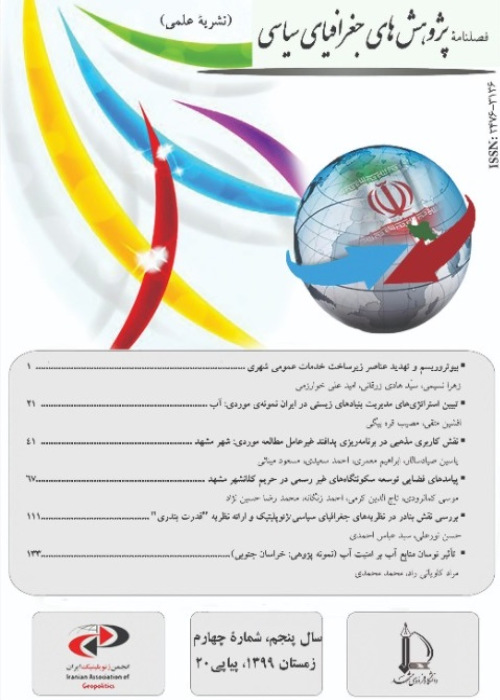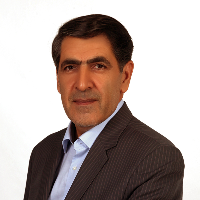The Development Programs in Iran and the Environmental Problems of Urmia Lake
Author(s):
Article Type:
Research/Original Article (دارای رتبه معتبر)
Abstract:
IntroductionSince the end of the Second World War, the development paradigm has become the dominant discourse in the world. During the more than 6 decades that the concept of development discourse has been dominant, many theoretical and practical developments have accompanied it. First, attention was solely paid on economic development and nature was considered as a facilitator of economic growth. However, it was gradually recognized that development with this economic growth approach changes the natural systems of the planet and leads to numerous environmental hazards that can threaten the economic and political systems of countries. Therefore, it is very possible for a political entity to attain the development, but sustained development will be faced with serious doubts because environmental aspects are ignored. Therefore, the concept of sustainable development replaced development.
MethodologyGiven the above- mentioned approach, this descriptive-analytic research examined the relationship between Development Programs and the environmental problems with Urmia Lake as a case example. To do this, an analytic and explanatory method, the accumulation of data and the existing literature have been adopted to carry out a library and document-based research.
DiscussionUrmia Lake, located in the northwestern part of Iran, is one of the salt over-saturated lakes in the world. This lake was introduced as a Biosphere Reserve to UNESCOs program of Man and the Biosphere and was included in the list of the Wetlands of this Convention on Wetlands of International Importance (Ramsar-1971). The water level in Urmia Lake was at its highest in 1995 and then, since 1995 up to 2012, it has declined more than seven meters. A review of other studies shows that although climate change and particularly evaporation increment are significant agents in decreasing the water level, the main causes of drying up the lake have been anthropogenic factors. For example, Lak, Darvishi Khatooni and Mohammadi (2011) suggested that although Iran has experienced a long-term drought since 13000 years ago up to now, Urmia Lake has never experienced dryness except in coastal areas and the main part of the lake has had lacustrine environment for 13000 years. On the other hand, according to Jamali, Sharifi, and Pourmand (2013), climate change never affects a single point selectively, and the performance of these changes is always on an extensive scale. The dramatic decrease in the water level of Lake Urmia has not been observed in the neighboring lakes such as the Sevan Lake in Armenia and Lake Van in Turkey. Therefore, the National Development Programs as well as development plans in the Urmia Lake Basin as human factors influencing the current situation and the environmental problems of Lake Urmia have been analyzed in this research. At present there are about 95 dams in the Urmia Lake Basin, 57 of which are operational, nine are under construction, and 29 are in the study phase. Moreover, water utilization has increased very rapidly in the past two decades and has depleted more than 90 percent of the water in the aquifers. The agriculture sector is the most important consumer of the water in this Basin and has experienced remarkable changes during the last three decades. So, The Development Programs have been one of the main reasons for the drying up of the Lake. The consequences resulting from the implementation of Development Plans in the Urmia Lake basin and drying the Lake are mainly the disruption of the biodiversity in the region, increased salinity, soil erosion, pollution of water sources, salt dust, and weather changes in the region that can threaten the sustainability of the development.
ConclusionThe analysis of the planning process and Development Programs in Iran shows that the patterns of development in Iran have always been based on economic growth which allows for achieving other economic and social goals. So, environmental resources have been considered as the foundation of national wealth and economic growth facilitator. Development with the economic growth approach has led to numerous environmental problems in the country of which Lake Urmia is an example. Therefore, it is possible for a political entity to attain development, but sustained development will be faced with serious doubts because environmental aspects are ignored.
MethodologyGiven the above- mentioned approach, this descriptive-analytic research examined the relationship between Development Programs and the environmental problems with Urmia Lake as a case example. To do this, an analytic and explanatory method, the accumulation of data and the existing literature have been adopted to carry out a library and document-based research.
DiscussionUrmia Lake, located in the northwestern part of Iran, is one of the salt over-saturated lakes in the world. This lake was introduced as a Biosphere Reserve to UNESCOs program of Man and the Biosphere and was included in the list of the Wetlands of this Convention on Wetlands of International Importance (Ramsar-1971). The water level in Urmia Lake was at its highest in 1995 and then, since 1995 up to 2012, it has declined more than seven meters. A review of other studies shows that although climate change and particularly evaporation increment are significant agents in decreasing the water level, the main causes of drying up the lake have been anthropogenic factors. For example, Lak, Darvishi Khatooni and Mohammadi (2011) suggested that although Iran has experienced a long-term drought since 13000 years ago up to now, Urmia Lake has never experienced dryness except in coastal areas and the main part of the lake has had lacustrine environment for 13000 years. On the other hand, according to Jamali, Sharifi, and Pourmand (2013), climate change never affects a single point selectively, and the performance of these changes is always on an extensive scale. The dramatic decrease in the water level of Lake Urmia has not been observed in the neighboring lakes such as the Sevan Lake in Armenia and Lake Van in Turkey. Therefore, the National Development Programs as well as development plans in the Urmia Lake Basin as human factors influencing the current situation and the environmental problems of Lake Urmia have been analyzed in this research. At present there are about 95 dams in the Urmia Lake Basin, 57 of which are operational, nine are under construction, and 29 are in the study phase. Moreover, water utilization has increased very rapidly in the past two decades and has depleted more than 90 percent of the water in the aquifers. The agriculture sector is the most important consumer of the water in this Basin and has experienced remarkable changes during the last three decades. So, The Development Programs have been one of the main reasons for the drying up of the Lake. The consequences resulting from the implementation of Development Plans in the Urmia Lake basin and drying the Lake are mainly the disruption of the biodiversity in the region, increased salinity, soil erosion, pollution of water sources, salt dust, and weather changes in the region that can threaten the sustainability of the development.
ConclusionThe analysis of the planning process and Development Programs in Iran shows that the patterns of development in Iran have always been based on economic growth which allows for achieving other economic and social goals. So, environmental resources have been considered as the foundation of national wealth and economic growth facilitator. Development with the economic growth approach has led to numerous environmental problems in the country of which Lake Urmia is an example. Therefore, it is possible for a political entity to attain development, but sustained development will be faced with serious doubts because environmental aspects are ignored.
Keywords:
Language:
Persian
Published:
Research Political Geography, Volume:2 Issue: 1, 2017
Pages:
1 to 29
magiran.com/p1833871
دانلود و مطالعه متن این مقاله با یکی از روشهای زیر امکان پذیر است:
اشتراک شخصی
با عضویت و پرداخت آنلاین حق اشتراک یکساله به مبلغ 1,390,000ريال میتوانید 70 عنوان مطلب دانلود کنید!
اشتراک سازمانی
به کتابخانه دانشگاه یا محل کار خود پیشنهاد کنید تا اشتراک سازمانی این پایگاه را برای دسترسی نامحدود همه کاربران به متن مطالب تهیه نمایند!
توجه!
- حق عضویت دریافتی صرف حمایت از نشریات عضو و نگهداری، تکمیل و توسعه مگیران میشود.
- پرداخت حق اشتراک و دانلود مقالات اجازه بازنشر آن در سایر رسانههای چاپی و دیجیتال را به کاربر نمیدهد.
دسترسی سراسری کاربران دانشگاه پیام نور!
اعضای هیئت علمی و دانشجویان دانشگاه پیام نور در سراسر کشور، در صورت ثبت نام با ایمیل دانشگاهی، تا پایان فروردین ماه 1403 به مقالات سایت دسترسی خواهند داشت!
In order to view content subscription is required
Personal subscription
Subscribe magiran.com for 70 € euros via PayPal and download 70 articles during a year.
Organization subscription
Please contact us to subscribe your university or library for unlimited access!



